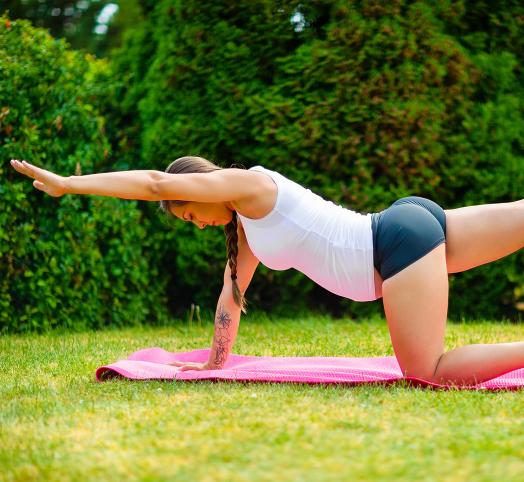For your and your baby... move, but in moderation.
Updated on March 22, 2023
Created on July 24, 2019
Find your nearest point of sale here
Updated on March 22, 2023
Created on July 24, 2019

Your body is made to move.
And pregnancy is not incompatible with physical and even sports activity, quite the contrary!
Provided, of course, you choose the right one and practice it correctly.
Four good reasons for moving your body We all know that being pregnant is not a disease and good health is closely related with physical activity. Yet the fact remains, whether because you do not feel like it or are overwhelmed with tiredness, you can soon be tempted to slip towards sedentariness...
This is a pity as during pregnancy, getting moving is key to staying healthy and better supporting the baby’s development and arrival. Fewer kilos, fewer cases of diabetes or high blood pressure: although the maximum allowable weight gain varies from one woman to another, clearly it must not be excessive.
Walking only 30 minutes a day is an easy way to keep the scales balanced and also reduces the risks of gestational diabetes and high blood pressure. Good circulation, a healthy heart: the weight gain and hormonal changes related with pregnancy contributes to the distension of the veins. Moving better oxygenates the tissues and tones the vein walls so that venous return takes place correctly and prevents the blood from stagnating.
Regular effort ensures the heart also learns to run on economy and respond better during intense exertion such as labour. Less stress and tiredness: By activating endorphin secretions, sport is the best way of combating stress and creating healthy tiredness.
It relaxes, improves endurance and makes you sleep better... all important factors for better recovery both during pregnancy and after giving birth. Back pain forgotten, improved digestive transit: physical activity naturally strengthens the postural muscles and abdominals which prevents back pain caused by the development of the baby.
And all that also provides a muscular massage on the intestine, with the knock-on result of improved activity and the cessation of problems with constipation and bloating that are so common during pregnancy. Choose the right activity Sport is good But pregnancy is not the time to take up boxing or kite surfing!
Opt for endurance activities, those that require sustained effort for at least 30 minutes without putting the body under strain.
The right activities: first of all, walking, of course! But also activities that support your weight and prevent putting strain on the joints: aquagym, swimming (in particular the back crawl to soothe lumbar back pain) and cycling, at moderate speed on level ground, approximately up to the 5th month of pregnancy. Yoga and gentle gymnastics are also advised but preferably under the guidance of an instructor accustomed to working with mothers-to-be to ensure that they avoid complicated postures.
Activities to forget about: all those with a degree of risk (mountaineering, diving, etc.) or that require sudden movements (tennis, squash, volley ball, etc.). Four tips before getting started Whatever the activity chosen, the aim is not to reach champion level but simply to help you get through the nine months of your pregnancy better.
Neither must it be punishing or a source of injury and in all cases must be reduced from the third trimester onwards. Go-ahead from your doctor: absolutely essential before starting of continuing with a sporting activity.
But also in the event of the slightest incident: palpitations, nausea, dizziness, unusual pains, loss of blood, etc. Listen to your body: it is the best gauge. If you feel tired, do not force yourself to swim another ten lengths. If your joints feel shaky, stop: your tendons and ligaments are hyperflexible during pregnancy and this can increase the risk of sprains.
The right gear: invest in an appropriate bra to provide support, anti-slip sports shoes, etc.
Nutritional habits: good regular hydration to compensate for the increase in water loss and mineral salts due to the activity (otherwise you will suffer cramps, among other things) and a small snack before and after the session to rule out hypoglycaemia and quickly replenish nutrient reserves.